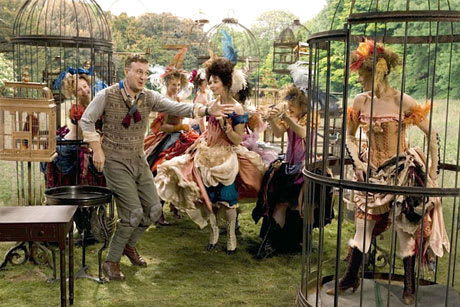One's enjoyment of The Magic Flute will have much to do with their appreciation of both the Opera and CGI, as there is nary a scene without digital enhancements, and perhaps five lines of dialogue that aren't sung. This shouldn't surprise anyone familiar with Mozart's decidedly light-hearted material but some of the less successful elements in this adaptation may raise eyebrows, along with some of the weightier anti-war material that bogs down much of the narrative, hindering the overall tone despite a technically superior overall achievement.
Structurally following the existing template of the opera, the film starts in the WWI trenches with a breathtaking seemingly single take of the lines of trenches, the battlefield and the planes above, with a richness of colour and visualization that sets a tone for what's to follow. During this battle, Tamino (Joseph Kaiser) is wounded and lost, then discovered by three cleavage-bearing nuns (Louise Callinan, Kim-Marie Woodhouse and Teuta Koco), who rescue the unconscious soldier, transforming into nurses upon his awakening.
The film then follows Tamino's journey to rescue the kidnapped Pamina (Amy Carson) from the evil Sarastro (Rene Pape), with best friend and comic relief Papageno (Benjamin Jay Davis) in tow. Romance abounds, as does a battle with Pamina's mother, the Queen of the Night (Lyubov Petrova), which frequently involves music and magical instruments.
While the actors were clearly cast for their ability to sing, their overly expressive theatrical tendencies keep audience connection at bay, despite the fact that it is intentional. Branagh's tendency to use long takes of wandering eyes in single sets suggests a stage-like environment but later artistically derived sequences of singing walls, straw-bale house creation and the occasional bout of rapid editing conflict with this, leaving the viewer outside of the action.
Distancing factors aside, there is nothing ostensibly wrong with The Magic Flute, as, in truth, it is consistently gorgeous and impeccably performed from the perspective of aesthetics and musicality. It's just a shame that it's nearly impossible to engage on an emotional level, as the potential exists within the material.
(Maximum)Structurally following the existing template of the opera, the film starts in the WWI trenches with a breathtaking seemingly single take of the lines of trenches, the battlefield and the planes above, with a richness of colour and visualization that sets a tone for what's to follow. During this battle, Tamino (Joseph Kaiser) is wounded and lost, then discovered by three cleavage-bearing nuns (Louise Callinan, Kim-Marie Woodhouse and Teuta Koco), who rescue the unconscious soldier, transforming into nurses upon his awakening.
The film then follows Tamino's journey to rescue the kidnapped Pamina (Amy Carson) from the evil Sarastro (Rene Pape), with best friend and comic relief Papageno (Benjamin Jay Davis) in tow. Romance abounds, as does a battle with Pamina's mother, the Queen of the Night (Lyubov Petrova), which frequently involves music and magical instruments.
While the actors were clearly cast for their ability to sing, their overly expressive theatrical tendencies keep audience connection at bay, despite the fact that it is intentional. Branagh's tendency to use long takes of wandering eyes in single sets suggests a stage-like environment but later artistically derived sequences of singing walls, straw-bale house creation and the occasional bout of rapid editing conflict with this, leaving the viewer outside of the action.
Distancing factors aside, there is nothing ostensibly wrong with The Magic Flute, as, in truth, it is consistently gorgeous and impeccably performed from the perspective of aesthetics and musicality. It's just a shame that it's nearly impossible to engage on an emotional level, as the potential exists within the material.
